Cottonmouth vs Rattlesnake: 5 Key Differences
Key Points
- While the cottonmouth resides in North America only in wet and marshy areas, the rattlesnake can be found in North, Central, and South America in mountains, deserts, and grassy habitats.
- Both cottonmouths and rattlesnakes are pit vipers and hard to tell apart. While cottonmouths have varied patterns on their bodies, the rattlesnake has diamond shaped patterns and the rattle on the end of its tail.
- A cottonmouth wards off predators by emitting a musk from its tail, while a rattlesnake will shake the rattle on its tail.
Both the cottonmouth vs rattlesnake have an extremely venomous bite, but have you ever wondered what differences they may share? Some of these snake species live in the same location and have similar physical characteristics, but how can you learn to tell them apart?
In this article, we will address all of the differences between a cottonmouth snake and a rattlesnake, including their typical behavior and dietary preferences. If you have always wanted to brush up on your snake identification skills, you’re in the right place! Let’s get started and learn about these two vipers now.
Comparing Cottonmouth vs Rattlesnake
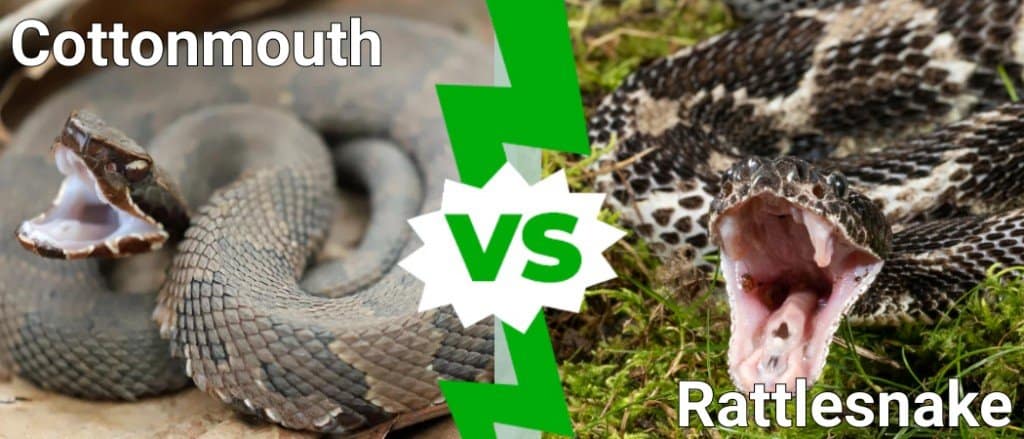
A-Z-Animals.com
| Cottonmouth | Rattlesnake | |
| Size | 2-6 feet long | 1-8 feet long |
| Appearance | Black, brown, and olive coloring; distinct thick body and white mouth or gums; large triangle head and alternating color body patterns | Coloring varies based on habitat; triangular head and vertical pupils; raised scales and diamond patterned body. Has a namesake rattle on the end of its tail |
| Location and Habitat | North America only; wetlands, watery habitats, and marshes | North, Central, and South America; mountains, deserts, grassy areas |
| Behavior | Avoids people and has less potent venom compared to rattlesnakes; shakes its tail and emits a musk to ward off predators | Extremely potent bite for humans, but prefers to be left alone; rattles its tail to ward off predators. Changes the times of day it hunts based on the season |
| Diet | Fish, rodents, shrews, frogs, reptiles, birds, insects, and eggs | Rats, mice, lizards, rats, and frogs |
Key Differences Between Cottonmouth vs Rattlesnake
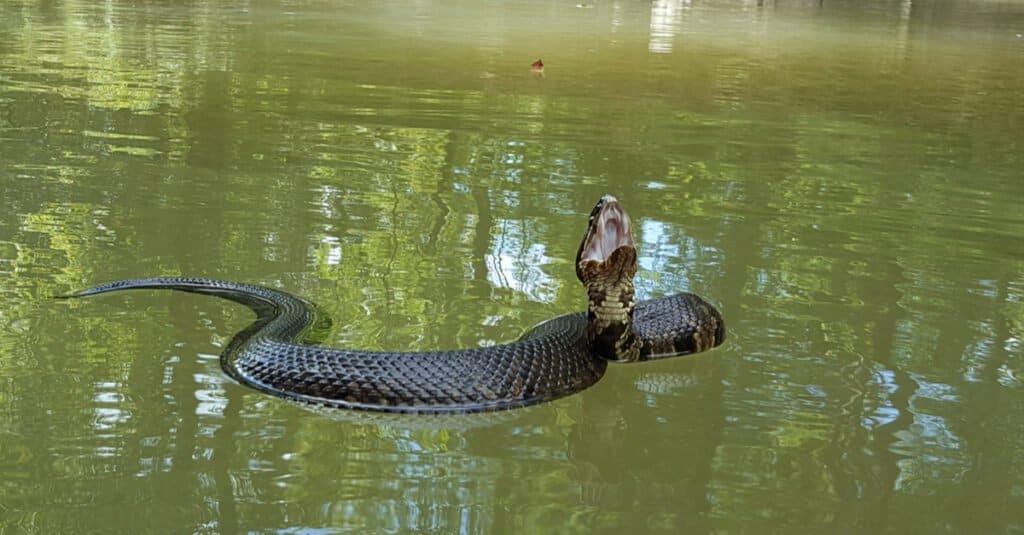
Seth LaGrange/Shutterstock.com
There are many key differences between a cottonmouth and a rattlesnake. Cottonmouths grow smaller than a wide variety of rattlesnake breeds, but both snakes have equally thick bodies. Rattlesnakes swim out of necessity and prefer to be on land, while cottonmouths enjoy living in aquatic environments. Finally, rattlesnakes have a distinct rattle at the end of their tails, while cottonmouths do not.
Let’s discuss some of these differences in more detail now.
Cottonmouth vs Rattlesnake: Size and Weight
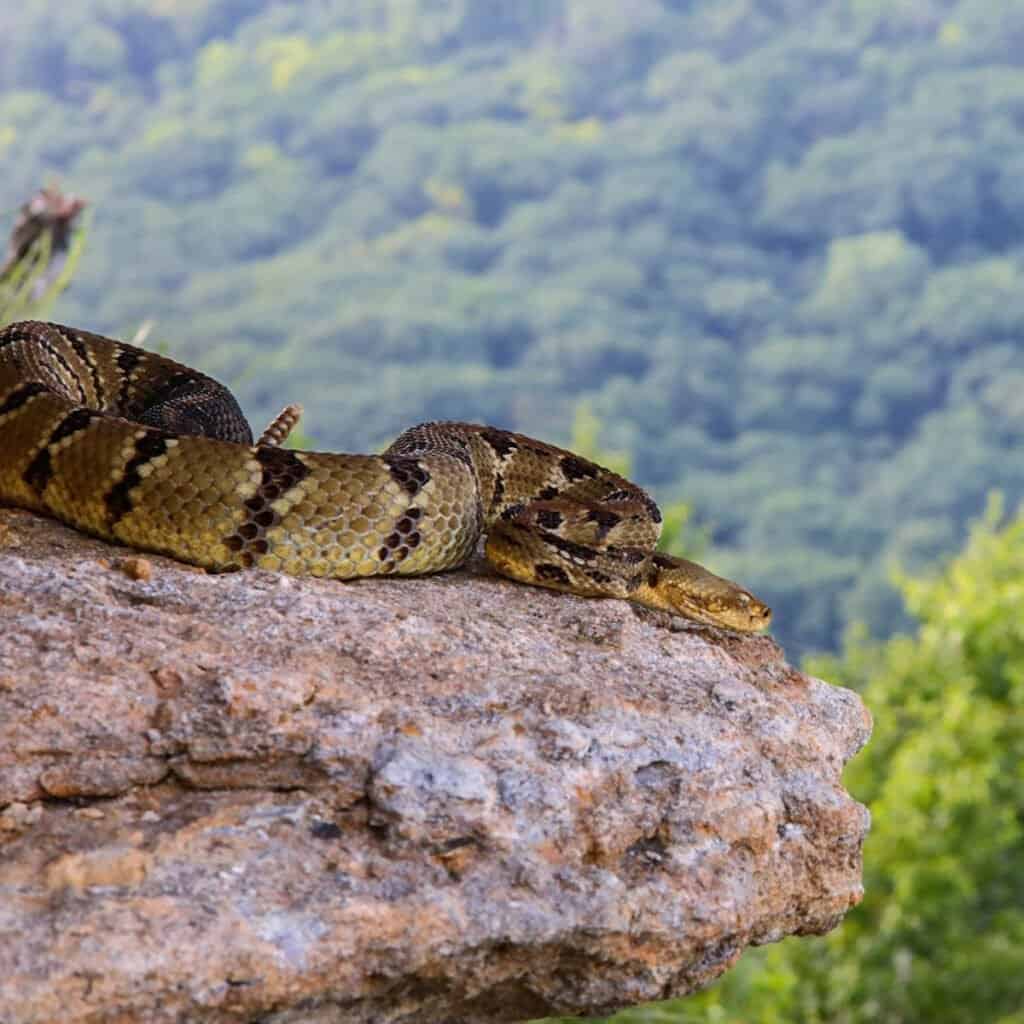
bradenjalexander/Shutterstock.com
A significant difference between a cottonmouth vs rattlesnake is their size and weight. Cottonmouths are smaller than the average rattlesnake, but it also depends on the specific breed or rattlesnake species. For example, rattlesnakes grow anywhere from 1-8 feet long, while cottonmouths grow 2–6 feet long on average.
There are certain rattlesnake species that grow much longer than cottonmouths, and vice versa. The Eastern diamondback rattlesnake reaches ten feet long on occasion, while cottonmouths rarely grow larger than six feet. However, some cottonmouths grow larger than certain rattlesnake species, so this isn’t a hard and fast rule.
Cottonmouth vs Rattlesnake: Location and Habitat Preferences
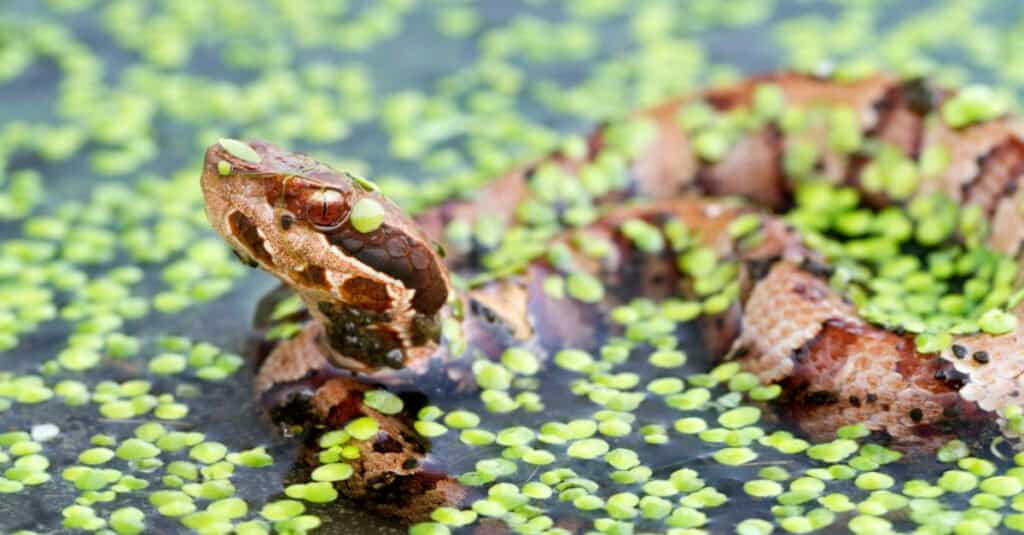
Mark_Kostich/Shutterstock.com
Both cottonmouths and rattlesnakes live in North America, specifically the southern United States. This means that you can find both of these snakes in the same habitat or environment, namely Florida. However, cottonmouths are only found in North America, while rattlesnakes are found in North, South, and Central America.
The preferred habitats of these two snakes also differ greatly. Cottonmouths enjoy living in watery or aquatic environments, such as marshes, wetlands, and alongside rivers and ponds. While rattlesnakes may also be found in these locations, they prefer spending their time on land, and in warm, dry climates.
The average rattlesnake lives in arid deserts and warm mountain climates. You can also find rattlesnakes in forested areas or grasslands, much like cottonmouths. However, rattlesnakes only choose to swim out of necessity, while cottonmouths enjoy swimming in many different aquatic settings.
Cottonmouth vs Rattlesnake: Appearance
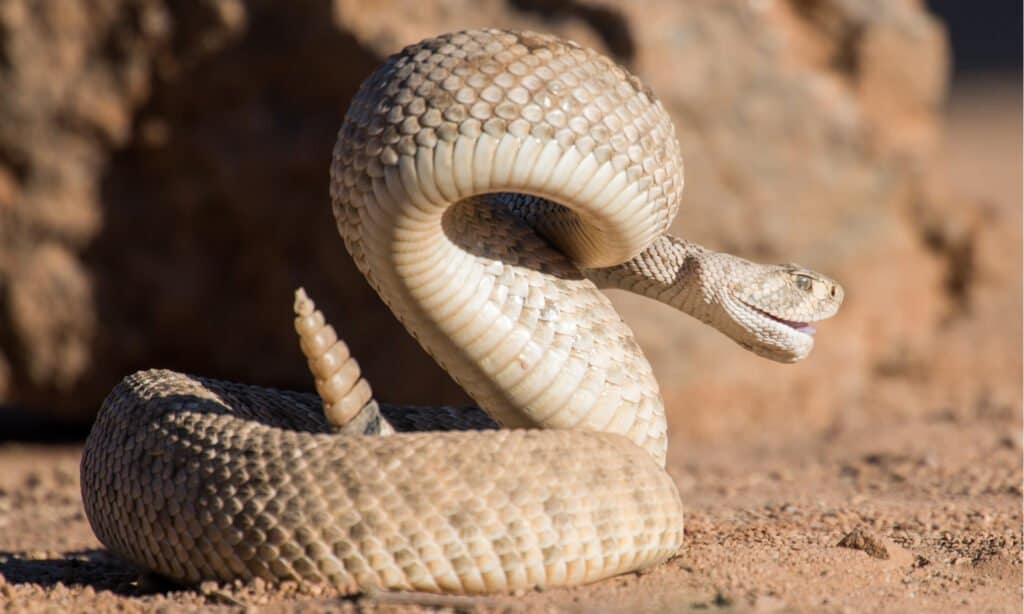
Susan M Snyder/Shutterstock.com
It can be extremely difficult to tell a cottonmouth apart from a rattlesnake. This is why the two snakes are often confused, and for good reason. They are both members of the pit viper family, but there are a few things that you can look out for in order to tell them apart. Let’s discuss some of these differences now.
Cottonmouths have patterned bodies in shades of brown or black, while rattlesnakes have a distinct diamond pattern on their bodies. Rattlesnakes are also found in more colors than cottonmouths, depending on their preferred habitat or location. Desert rattlesnakes have tan or even yellow and peach colored scales, while cottonmouths never have scales in these shades.
Cottonmouths can be easily identified by their bright white mouths, while rattlesnakes do not have white mouths. You can also identify a rattlesnake by its namesake rattle on the end of its tail. Both of these snakes have earned names based on how you can best identify them, so keep these names in mind should you come across a snake while hiking!
Cottonmouth vs Rattlesnake: Behavior
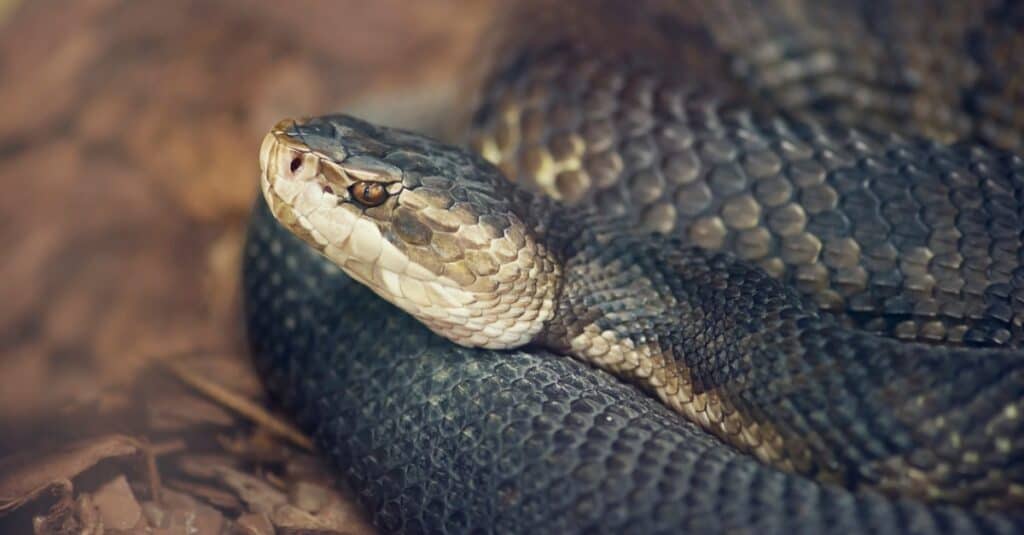
iStock.com/Saddako
Another difference between cottonmouths vs rattlesnakes is their behavior. While both of these snakes prefer to be left alone and only bite when threatened, they exhibit different responses if they feel cornered or threatened. For example, rattlesnakes rattle their tails and coil up, while cottonmouths mimic a rattlesnake’s rattle and emit a musk that deters predators.
A cottonmouth’s venom is also not as potent as a rattlesnake’s. This is important to note, though both bites are extremely painful and can be life threatening if left untreated. Rattlesnakes also change the time of day that they hunt based on the season, while cottonmouths maintain a diurnal hunting schedule, which means they are active during the day (as opposed to nocturnal animals.)
Besides shaking its tale, the cottonmouth snake will also gape its mouth open when threatened to show the white lining, trying to scare away the predator. It does this to send the message that you are in its space, and it would prefer it if you retreat. Studies have shown that it’s rare for cottonmouths to bite humans in self-defense; rather, they will gape, attempt escape, or vibrate their tails.
Cottonmouth vs Rattlesnake: Diet and Hunting Style

Creeping Things/Shutterstock.com
A final difference between cottonmouths and rattlesnakes is their diet and hunting style. While both of these snakes inject their prey with a powerful and immobilizing venom, cottonmouths eat a wider variety of things compared to rattlesnakes. For example, rattlesnakes eat rats, mice, lizards, frogs, squirrels, and rabbits, while cottonmouths eat fish, rodents, shrews, frogs, reptiles, birds, insects, and eggs.
Summary of Cottonmouth vs Rattlesnake
| Trait | Cottonmouth | Rattlesnake |
|---|---|---|
| Location | North America | North, Central, & South America |
| Habitat | Rivers, Lakes, Swamps, Marshes | Mountains, deserts, and grasslands |
| Appearance | Patterned bodies in brown or black; bright white mouths | Distinct diamond pattern on body; more color varieties like tan, peach, or yellow scales; rattle at end of tail |
| Size | 2-6 feet long | 1-8 feet long |
| Diet | Fish, rodents, shrews, frogs, reptiles, birds, insects, eggs | Rats, mice, lizards, frogs, squirrels, rabbits |
Up Next…
Keep reading! We think you’ll like these other pages about snakes and other amazing animals.
- Discover the 10 Weirdest Snakes in the World
- Meet the Snake With Legs & How It Was Different From a Lizard
- Snake Population By State
- Yellow-Bellied Watersnake Vs Cottonmouth
- Cottonmouth Vs Timber Rattlesnake
- 96 Snakes Found In Texas (14 are Venomous!)
- Coachwhip Snake vs Rattlesnake: 4 Major Differences
Discover the “Monster” Snake 5X Bigger than an Anaconda
Every day A-Z Animals sends out some of the most incredible facts in the world from our free newsletter. Want to discover the 10 most beautiful snakes in the world, a “snake island” where you’re never more than 3 feet from danger, or a “monster” snake 5X larger than an anaconda? Then sign up right now and you’ll start receiving our daily newsletter absolutely free.
More from A-Z Animals
Key Points
- While the cottonmouth resides in North America only in wet and marshy areas, the rattlesnake can be found in North, Central, and South America in mountains, deserts, and grassy habitats.
- Both cottonmouths and rattlesnakes are pit vipers and hard to tell apart. While cottonmouths have varied patterns on their bodies, the rattlesnake has diamond shaped patterns and the rattle on the end of its tail.
- A cottonmouth wards off predators by emitting a musk from its tail, while a rattlesnake will shake the rattle on its tail.
Both the cottonmouth vs rattlesnake have an extremely venomous bite, but have you ever wondered what differences they may share? Some of these snake species live in the same location and have similar physical characteristics, but how can you learn to tell them apart?
In this article, we will address all of the differences between a cottonmouth snake and a rattlesnake, including their typical behavior and dietary preferences. If you have always wanted to brush up on your snake identification skills, you’re in the right place! Let’s get started and learn about these two vipers now.
Comparing Cottonmouth vs Rattlesnake

A-Z-Animals.com
| Cottonmouth | Rattlesnake | |
| Size | 2-6 feet long | 1-8 feet long |
| Appearance | Black, brown, and olive coloring; distinct thick body and white mouth or gums; large triangle head and alternating color body patterns | Coloring varies based on habitat; triangular head and vertical pupils; raised scales and diamond patterned body. Has a namesake rattle on the end of its tail |
| Location and Habitat | North America only; wetlands, watery habitats, and marshes | North, Central, and South America; mountains, deserts, grassy areas |
| Behavior | Avoids people and has less potent venom compared to rattlesnakes; shakes its tail and emits a musk to ward off predators | Extremely potent bite for humans, but prefers to be left alone; rattles its tail to ward off predators. Changes the times of day it hunts based on the season |
| Diet | Fish, rodents, shrews, frogs, reptiles, birds, insects, and eggs | Rats, mice, lizards, rats, and frogs |
Key Differences Between Cottonmouth vs Rattlesnake

Seth LaGrange/Shutterstock.com
There are many key differences between a cottonmouth and a rattlesnake. Cottonmouths grow smaller than a wide variety of rattlesnake breeds, but both snakes have equally thick bodies. Rattlesnakes swim out of necessity and prefer to be on land, while cottonmouths enjoy living in aquatic environments. Finally, rattlesnakes have a distinct rattle at the end of their tails, while cottonmouths do not.
Let’s discuss some of these differences in more detail now.
Cottonmouth vs Rattlesnake: Size and Weight

bradenjalexander/Shutterstock.com
A significant difference between a cottonmouth vs rattlesnake is their size and weight. Cottonmouths are smaller than the average rattlesnake, but it also depends on the specific breed or rattlesnake species. For example, rattlesnakes grow anywhere from 1-8 feet long, while cottonmouths grow 2–6 feet long on average.
There are certain rattlesnake species that grow much longer than cottonmouths, and vice versa. The Eastern diamondback rattlesnake reaches ten feet long on occasion, while cottonmouths rarely grow larger than six feet. However, some cottonmouths grow larger than certain rattlesnake species, so this isn’t a hard and fast rule.
Cottonmouth vs Rattlesnake: Location and Habitat Preferences

Mark_Kostich/Shutterstock.com
Both cottonmouths and rattlesnakes live in North America, specifically the southern United States. This means that you can find both of these snakes in the same habitat or environment, namely Florida. However, cottonmouths are only found in North America, while rattlesnakes are found in North, South, and Central America.
The preferred habitats of these two snakes also differ greatly. Cottonmouths enjoy living in watery or aquatic environments, such as marshes, wetlands, and alongside rivers and ponds. While rattlesnakes may also be found in these locations, they prefer spending their time on land, and in warm, dry climates.
The average rattlesnake lives in arid deserts and warm mountain climates. You can also find rattlesnakes in forested areas or grasslands, much like cottonmouths. However, rattlesnakes only choose to swim out of necessity, while cottonmouths enjoy swimming in many different aquatic settings.
Cottonmouth vs Rattlesnake: Appearance

Susan M Snyder/Shutterstock.com
It can be extremely difficult to tell a cottonmouth apart from a rattlesnake. This is why the two snakes are often confused, and for good reason. They are both members of the pit viper family, but there are a few things that you can look out for in order to tell them apart. Let’s discuss some of these differences now.
Cottonmouths have patterned bodies in shades of brown or black, while rattlesnakes have a distinct diamond pattern on their bodies. Rattlesnakes are also found in more colors than cottonmouths, depending on their preferred habitat or location. Desert rattlesnakes have tan or even yellow and peach colored scales, while cottonmouths never have scales in these shades.
Cottonmouths can be easily identified by their bright white mouths, while rattlesnakes do not have white mouths. You can also identify a rattlesnake by its namesake rattle on the end of its tail. Both of these snakes have earned names based on how you can best identify them, so keep these names in mind should you come across a snake while hiking!
Cottonmouth vs Rattlesnake: Behavior

iStock.com/Saddako
Another difference between cottonmouths vs rattlesnakes is their behavior. While both of these snakes prefer to be left alone and only bite when threatened, they exhibit different responses if they feel cornered or threatened. For example, rattlesnakes rattle their tails and coil up, while cottonmouths mimic a rattlesnake’s rattle and emit a musk that deters predators.
A cottonmouth’s venom is also not as potent as a rattlesnake’s. This is important to note, though both bites are extremely painful and can be life threatening if left untreated. Rattlesnakes also change the time of day that they hunt based on the season, while cottonmouths maintain a diurnal hunting schedule, which means they are active during the day (as opposed to nocturnal animals.)
Besides shaking its tale, the cottonmouth snake will also gape its mouth open when threatened to show the white lining, trying to scare away the predator. It does this to send the message that you are in its space, and it would prefer it if you retreat. Studies have shown that it’s rare for cottonmouths to bite humans in self-defense; rather, they will gape, attempt escape, or vibrate their tails.
Cottonmouth vs Rattlesnake: Diet and Hunting Style

Creeping Things/Shutterstock.com
A final difference between cottonmouths and rattlesnakes is their diet and hunting style. While both of these snakes inject their prey with a powerful and immobilizing venom, cottonmouths eat a wider variety of things compared to rattlesnakes. For example, rattlesnakes eat rats, mice, lizards, frogs, squirrels, and rabbits, while cottonmouths eat fish, rodents, shrews, frogs, reptiles, birds, insects, and eggs.
Summary of Cottonmouth vs Rattlesnake
| Trait | Cottonmouth | Rattlesnake |
|---|---|---|
| Location | North America | North, Central, & South America |
| Habitat | Rivers, Lakes, Swamps, Marshes | Mountains, deserts, and grasslands |
| Appearance | Patterned bodies in brown or black; bright white mouths | Distinct diamond pattern on body; more color varieties like tan, peach, or yellow scales; rattle at end of tail |
| Size | 2-6 feet long | 1-8 feet long |
| Diet | Fish, rodents, shrews, frogs, reptiles, birds, insects, eggs | Rats, mice, lizards, frogs, squirrels, rabbits |
Up Next…
Keep reading! We think you’ll like these other pages about snakes and other amazing animals.
- Discover the 10 Weirdest Snakes in the World
- Meet the Snake With Legs & How It Was Different From a Lizard
- Snake Population By State
- Yellow-Bellied Watersnake Vs Cottonmouth
- Cottonmouth Vs Timber Rattlesnake
- 96 Snakes Found In Texas (14 are Venomous!)
- Coachwhip Snake vs Rattlesnake: 4 Major Differences
Discover the “Monster” Snake 5X Bigger than an Anaconda
Every day A-Z Animals sends out some of the most incredible facts in the world from our free newsletter. Want to discover the 10 most beautiful snakes in the world, a “snake island” where you’re never more than 3 feet from danger, or a “monster” snake 5X larger than an anaconda? Then sign up right now and you’ll start receiving our daily newsletter absolutely free.







